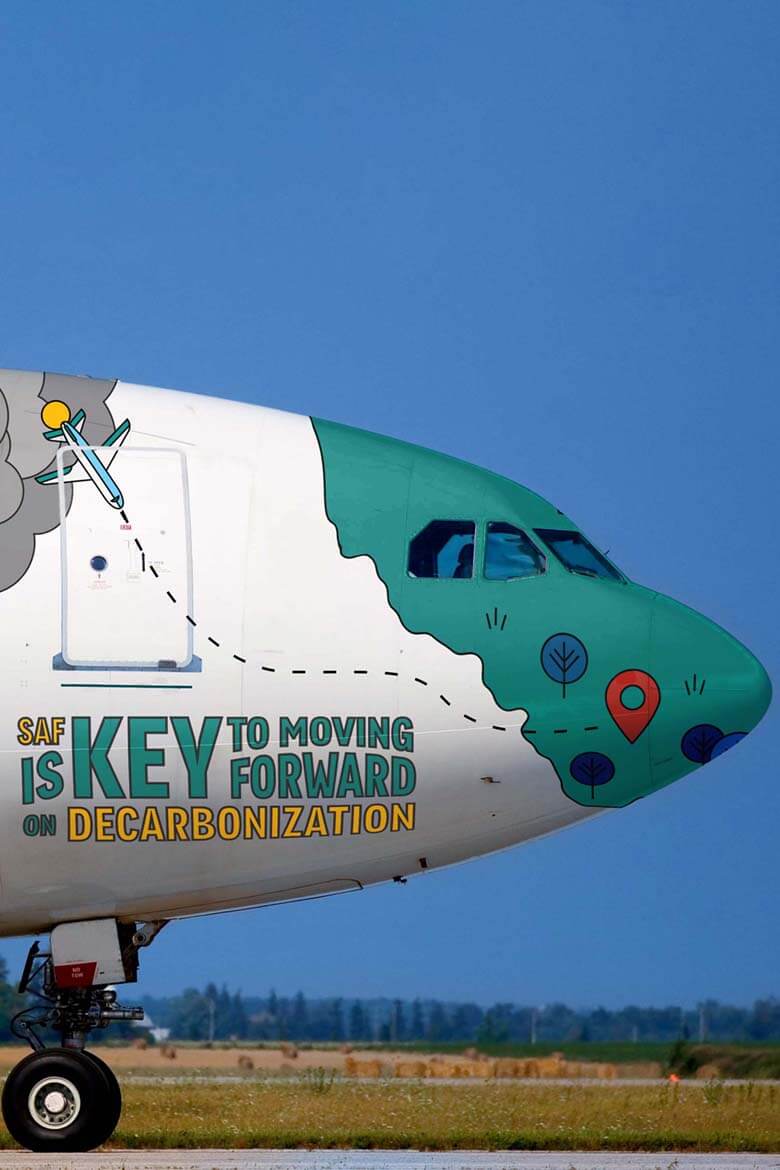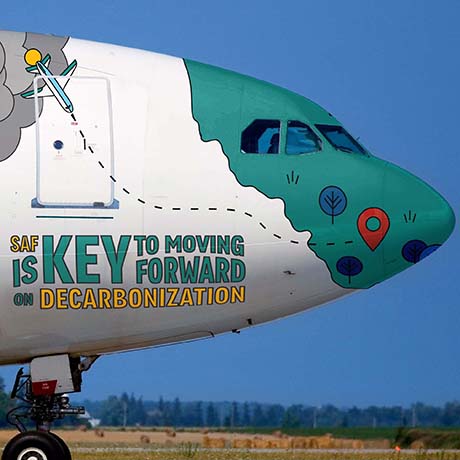Sustainable aviation fuel (SAF) — a biofuel similar in chemistry to conventional jet fuel but with significantly fewer emissions — is probably the most important, and definitely the most immediate, tool airlines can use in their quest for net zero. Yet, by 2030, despite dozens of new production facilities and billions of dollars invested in SAF production, there simply won’t be enough to stop the rise in global aviation emissions — let alone reduce it.
To limit emissions from air travel to 2019 levels, about 15% of the jet fuel consumed in 2030 would have to be SAF. That’s equivalent to a supply of about 16 billion gallons, based on Oliver Wyman’s projections for growth in the global commercial aircraft fleet and demand for travel. But the best-case scenario for SAF supply in 2030 is for only about 5.4 billion gallons to be produced. That would represent only about 5% of jet fuel consumption globally, which would mean a rise in airline emissions. The more likely scenario is for a production of only about 3.1 billion gallons — and that means an even bigger rise in emissions.
While governments in the United States and Europe have tried to encourage more production, their efforts haven’t yet moved the needle. Recently, the US has been more aggressive, passing a generous tax credit for SAF and pledging $4 billion as starter money to build three billion gallons of capacity, equaling about 10% of the US demand for jet fuel. The European Commission has proposed a mandate requiring the blending of a minimum of 2% SAF or other low-carbon fuels with conventional jet fuel beginning in 2025. The mandate would increase in five year intervals until it reached 63% in 2050. Still, more government support is needed if SAF production is to attract the additional investment necessary from the private sector and the industry is to cut its emissions.
No other options
For aviation, considered a very hard-to-abate industry, SAF is the key for substantial forward movement on decarbonization. Technological and operational advances that help the industry steadily improve fuel efficiency only produce a reduction of about 1% to 2% per annum — not nearly enough to offset rising emissions from expanding air travel. Additionally, aircraft powered by low-carbon technologies, such as batteries, hydrogen fuel cells, or hydrogen as a fuel, are unlikely to be manufactured in volume until the second half of the 2030s. Then, it will take several more decades before most of the tens of thousands of fossil fuel-propelled aircraft are retired and replaced with these low-carbon technology alternatives.
That leaves SAF — a gallon of which emits up to 80% less carbon dioxide than conventional jet fuel — as the primary option to reduce emissions from conventional aircraft, requiring a steady expansion of SAF supply through 2050. The International Air Transport Association (IATA) estimates that almost 450 billion liters of SAF would be needed annually by 2050. That’s significantly more than the 125 million liters produced today.
The role of incentives
Many airlines have come to understand the pivotal role SAF has to play moving forward and are encouraging SAF production with pledges of 10% usage by 2030. Those commitments, while not binding, exceed the proposed blending targets called for by the European Commission and IATA. But SAF producers still worry that airlines will not follow through because SAF runs two to three times the price of conventional jet fuel. So far, there hasn’t been enough investment in SAF production because of the fuel’s opaque pricing environment. And until recently, there also hasn’t been the same kind of government support behind early market development enjoyed by other green technologies, such as renewable diesel (RD) and renewable energy.
US production of RD — used by road transport — grew 300% between 2017 and 2021, thanks in large part to federal mandates, such as the Renewable Fuel Standard, and incentives like a $1 blender’s tax credit. These government regulations encouraged investment in RD by helping to guarantee the development of the market and reducing investor risk. While SAF was also privy to that blender’s tax credit, it was insufficient because of the extra cost to produce SAF and the size of the aviation fuel market, which is smaller than road transport. Under the new tax incentive, companies would get $1.25 to $1.75 credit for each gallon of SAF blended with conventional jet fuel.
Probably the key ingredient to reaching at least the best-case scenario for SAF is figuring out how to get swing biofuel capacity — the 20% or so of production capable of turning out either RD or SAF — to switch to SAF. That’s not that easy given the maturity of the RD marketplace, with its large-scale players and long-term mandates and incentives.
Other necessary support
Another important element in any effort to increase SAF production should be encouraging development of new feedstocks to help reduce production costs and ensure adequate supply. While most biofuels, including SAF, currently rely on hydroprocessed esters and fatty acids (HEFA) from used cooking oils, animal fats and other bio waste, there are other emerging technologies that could expand the feedstock supply and increase market options.
Among the most promising alternative feedstocks are municipal solid waste and woody biomass byproducts, which are turned into SAF via gasification technology. At this point, the technology is both low yield and expensive to build. But if these plentiful and less expensive feedstocks are successfully developed, they could prove critical to driving long-term scale in SAF — well past HEFA’s potential.
The long-term goal in SAF continues to be e-SAF, which is fuel produced directly from captured CO2, using renewable energy and green hydrogen with negligible environmental impact. In theory, this feedstock has an unlimited supply, but it requires copious amounts of green electricity. The technology is a decade or more from commercial maturity and is expensive, even by biofuel standards.
With the right government support and collaboration among energy companies, airlines, and aerospace manufacturers, the next several decades could see SAF play a consequential, even historic role in reducing aviation emissions. But SAF faces a vexing Catch-22: Production won’t expand sufficiently without binding commitments from airlines, and carriers will be unlikely to provide the commitments without guarantees of adequate supply.

